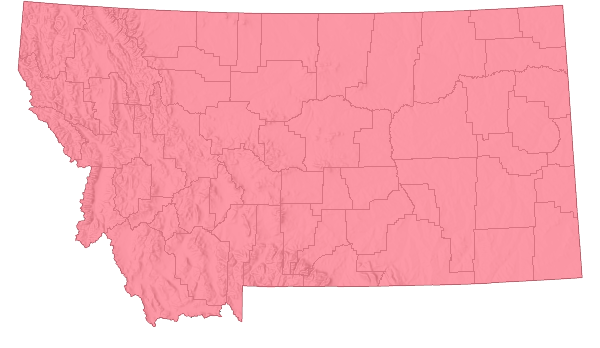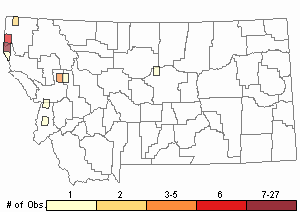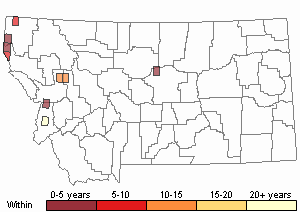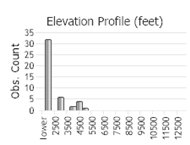View in other NatureServe Network Field Guides
NatureServe
Montana
Utah
Wyoming
Idaho
Wisconsin
British Columbia
South Carolina
Yukon
California
New York
Scotch Broom - Cytisus scoparius
State Rank Reason (see State Rank above)
Cytisus scoparius is a plant native to central and southern Europe and North Africa (Graves et al. 2010). It is an exotic ornamental plant found in eastern and western North America (NRCS PLANTS database; https://plants.usda.gov). A conservation status rank is not applicable (SNA) because the plant is an exotic (non-native) in Montana that is not a suitable target for conservation activities.
General Description
PLANTS: Perennial deciduous shrubs that grow to about 3 meters tall with a profusion of yellow flowers. Stems are green and strongly angled. Sources: Graves et al. 2010; Lesica et al. 2012.
LEAVES: Arranged alternately along the stem. The lower portions of stems have leaves composed of 3 leaflets that are nearly sessile (clover-like). The upper portions of stems may have leaves that are simple (1 blade). The leaflets are elliptic but widest above their middle, 6–15 mm long, have a pointed tip with smooth (entire) margins, and lack stipules. Leaflets are sometimes hairy. Sources: Graves et al. 2010; Lesica et al. 2012.
INFLORESCENCE: Bright, yellow flowers occur in long, terminal racemes or as 1 to 3 flowers in the axils of leaves. Sources: Graves et al. 2010; Lesica et al. 2012.
Phenology
Flowering in spring and seed dispersal occurring from mid-July to mid-August.
Diagnostic Characteristics
Scotch Broom is identified by the combination of these characteristics:
* true shrubs with bright yellow flowers,
* clover-like leaves (1-3 leaflets) that lack a petiole (leaf stem) and stipules,
* square stems with no spines, and
* pods that turn black with hairs that only occur along the suture.
Amorpha, Robinia, Dalea, or
Caragana are shrubs also in the Pea Family, but they lack bright yellow flowers and have at least five leaflets pinnately arranged.
Thermopsis rhombifolia and
Thermopsis montana [Golden Pea]:
* robust forbs that can appear woody at their base,
* showy yellow flowers that grow in leaf axils and terminal on banch-ends.
* clover-like leaves that have 3-leaflets, a petiole (stem), and a stipule.
* have two types of stipules: Stipules on the lower stems are brown and paper and grow at leafless nodes. Stipules on the upper stems occur at the leaf node, are green, and resemble leaflets.
Although not currently known in Montana the closest look-alikes are:
*
Portuguese Broom(
Cytisus striatus) has bright yellow flowers and hairy seed pods.
*
White Spanish Broom(
Cytisus striatus) has white flowers and hairy seed pods.
*
Gorse(
Ulex europaeus) has shiny, bright yellow flowers and nasty spines.
Species Range
Montana Range
Range Descriptions

 Non-native
Non-native
Range Comments
Scotch Broom is native to central and southern Europe and North Africa (Graves et al. 2010). It was introduced into North America during the 1850’s as an ornamental and also used to control soil erosion (Graves et al. 2010). It has become invasive in the eastern and western U.S. and numerous countries (Graves et al. 2010).
In Montana it was first reported in 1987 along the Cabinet Gorge Reservoir on the Clark Fork River in Sanders County (Consortium of Pacific Northwest Herbaria, http://www.pnwherbaria.org/), where recent observations confirm it is still present. Observations reports from 2003-2018 have also found it in other locations along the Cabinet Gorge Reservoir as well as in Lincoln and Ravalli Counties. However, no one has submitted specimens to our University herbaria.
For maps and other distributional information on non-native species see:
Nonindigenous Aquatic Species Database from the U.S. Geological Survey
Invasive Species Habitat Tool (INHABIT) from the U.S. Geological Survey
Invasive Species Compendium from the Centre for Agriculture and Bioscience International (CABI)
EDDMapS Species Information EDDMapS Species Information
Observations in Montana Natural Heritage Program Database
Number of Observations: 51
(Click on the following maps and charts to see full sized version)
Map Help and Descriptions
Relative Density

Recency



 (Observations spanning multiple months or years are excluded from time charts)
(Observations spanning multiple months or years are excluded from time charts)
Habitat
Shrubs grow in disturbed areas, particularly along moist roadsides and in utility right-of-ways, pastures, open forests, gravel pits, and cultivated fields (Graves et al. 2010; Lesica et al. 2012). In other states it has also colonized undisturbed shrubland, grassland, and forests below 4,000 feet elevation (Graves et al. 2010).
Ecology
Scotch Broom out-competes other plants for light and nutrition resulting in a loss of plant species diversity (Graves et al. 2010). It can form monocultures. It is one of the few shrubs shown to impact coniferous forests (Graves et al. 201). In dry years it has been found to reduce the biomass of juvenile Douglas-fir trees.
Scotch Broom contains the quinolizidine alkaloids, sparteine and isosparteine, which are toxic to livestock. Livestock poisonings in the U.S. are apparently very rare, but have been reported in Europe.
Scotch Broom can be a host for several species of the pathogen Phytophthora. These pathogens can cause root rot and other diseases.
Reproductive Characteristics
Plants reproduce only by seed (Graves et al. 2010).
FLOWERS [Sources: Graves et al. 2010; Lesica et al. 2012.]
Typical pea-type (papilionaceous) flowers consist of a banner petal, two wing petals, and two fused keel petals. The calyx is tubular, 5–6 mm long, glabrous, and composed of unequal-sized green sepals. The corolla is bright yellow, 15–22 mm long. Occasionally flowers can have red or purple petals. Styles are curved and longer than the keel petal. There are 10 stamens, with 4 being longer than the others.
FRUIT [Sources: Graves et al. 2010; Lesica et al. 2012.]
A legume that is linear-oblong, flattened, 25–40 mm long, ciliate (hairy) on the sutures, and contains 5-9 seeds. The legume is green when immature and black when mature. Seeds have a small crest-like growth at the hilum.
LIFE CYCLE [Sources: Graves et al. 2010]
Scotch broom shrubs can live for 20 or more years and reach their full height within 6 to 10 years. At about two years of age, shrubs flower and produce seeds. Flowering occurs in the spring, often reaching its peak in May through June. Bees pollinate flowers, and fruits quickly develop. Seed production ranges from 4,000 to at least 30,000 seeds per plant. Seed dispersal occurs from mid-July to mid-August. Seeds can remain viable in the soil for up to 30 years. Buried seeds may have a delayed germination, but can germinate from a depth of 6 cm. Seeds can germinate in sunny areas and under canopies with as little as 10% ambient sunlight.
On their own, seeds disperse within one meter (3 feet) of their parent. Ants disperse seeds, transporting them up to five meters (15 feet) away from where they fall. Seed dispersal is also aided by humans through improper vegetation management, vehicles, and other mechanized equipment.
Management
Proper identification, early detection, and control of Scotch Broom in previously non-infested sites is the key to preventing the establishment of new colonies in Montana.
PREVENTION [Adapted from Graves et al. 2010]
Preventing spread is key to keeping a small distribution that can be eradicated in Montana. Seed dispersal must be prevented. Dispersal by humans should be eradicated by avoiding infested areas and cleaning vehicles before moving from infested to non-infested areas.
Proper identification is critical. New or potential sitings should be confirmed by contacting your local county extension agent, weed district coordinator, or State herbarium at University of Montana-Missoula, Montana State University-Bozeman, or Montana State University-Billings.
It is essential to properly manage forests, lawns, pastures, roadsides, and rangeland to maintain desirable plants in a healthy condition because land disturbances invite Scotch Broom.
PHYSICAL and CULTURAL CONTROLS [Adapted from Graves et al. 2010]
Mowing or
cutting stems at the end of the summer has been found to significantly reduce re-sprouting and eventually populations if conducted repeatedly. Soil should not be disturbed or that will stimulate seed germination. A rotary mower twists stems off, but does not cut, and can control Scotch Broom but does not eliminate re-sprouting and can damage non-target plants.
Burning using multiple prescribed fires can effectively control Scotch Broom. Burning is more-effective when done in mid-summer as new plants are sprouting. A high-intensity burn followed 2-3 years later by a low-intensity burn can provide long-term control. Higher intensity burns are needed to kills seeds, but may make it hard for establishing desirable vegetation, creating habitat for weed species. Burning trials conducted on French Broom (
Genista monspessulana) in New Zealand and Australia found burning increased seed germination.
Revegetation may be necessary for disturbed areas in order to develop healthy, desirable vegetation. Herbicide application followed by re-seeding of desirable plants may be necessary.
GRAZING CONTROL [Adapted from Graves et al. 2010]
Scotch Broom is toxic to cattle, but has not been reported for goats or llamas. In a field trial in British Columbia, Canada sheet would not eat Scotch Broom. On the contrary in New Zealand, goats grazing shrubs for several seasons has successfully controlled Scotch Broom.
CHEMICAL CONTROL [Adapted from Graves et al. 2010]
The seed bank may make it necessary to apply herbicides after re-seeding or planting tree saplings. Repeated treatments may also be necessary. The herbicide type and concentration, timing of chemical control, soil properties, and other factors will determine its effectiveness and impact to non-target species. Strict adherence to application requirements defined on the herbicide label will reduce risks to human and environmental health. Many herbicides must be applied by applicators with an Aquatic Pest Control license. Consult your County Extension Agent and/or Weed District for more information on herbicidal control.
Glyphosatewith a non-ionic surfactant (1.25-1.5 % solution) can be applied to fully-developed leaves to control established plants.
During active plant growth,
2,4-D plus
Triclopyr can be used as a broadcast application (1.5 gallons per acre) or as a high-volume foliar application (1-1.5 % mixture).
Triclopyr or
Picloram can be used at label rates for either rnon-crop (pasture or rangeland) or forest preparation.
BIOLOGICAL CONTROL [Adapted from Graves et al. 2010]
In Montana no bio-control insects are known to occur.
In the 1970s and 1980s the
Twig-boring Moth (
Leucoptera spartifoliella) and a
Seed Weevil (
Exapion fuscirostre) were released in California for Scotch Broom control. The Twig-boring Moth is subject to insect parasitism. The Seed Weevil larvae consumes seeds, but does not negatively impact shrubs.
A
Broom Seed Beetle (
Bruchidius villosus) was released in Oregon. The adults feed on pollen while the larvae feed on seeds inside the pods.
Montana's Scotch Broom Task Force is led by Kellieann Morris who can be contacted at: (406) 777-5842 or
kmorris@rc.mt.govUseful Links:Central and Eastern Montana Invasive Species TeamMontana Invasive Species websiteMontana Biological Weed Control Coordination ProjectMontana Department of Agriculture - Noxious WeedsMontana Weed Control AssociationMontana Weed Control Association Contacts WebpageMontana Fish, Wildlife, and Parks - Noxious WeedsMontana State University Integrated Pest Management ExtensionWeed Publications at Montana State University Extension - MontGuidesStewardship Responsibility
Threats or Limiting Factors
Scotch Broom out-competes other plants for light and nutrients causing a reduction in plant species diversity.
References
- Literature Cited AboveLegend:
 View Online Publication
View Online Publication Graves, Melissa, Jane Mangold, and Jim Jacobs. 2010. Biology, Ecology, and Management of Scotch broom (Cytisus scoparius L.).
Graves, Melissa, Jane Mangold, and Jim Jacobs. 2010. Biology, Ecology, and Management of Scotch broom (Cytisus scoparius L.). Lesica, P., M.T. Lavin, and P.F. Stickney. 2012. Manual of Montana Vascular Plants. Fort Worth, TX: BRIT Press. viii + 771 p.
Lesica, P., M.T. Lavin, and P.F. Stickney. 2012. Manual of Montana Vascular Plants. Fort Worth, TX: BRIT Press. viii + 771 p.
- Additional ReferencesLegend:
 View Online Publication
View Online Publication
Do you know of a citation we're missing? Lesica, P., M.T. Lavin, and P.F. Stickney. 2022. Manual of Montana Vascular Plants, Second Edition. Fort Worth, TX: BRIT Press. viii + 779 p.
Lesica, P., M.T. Lavin, and P.F. Stickney. 2022. Manual of Montana Vascular Plants, Second Edition. Fort Worth, TX: BRIT Press. viii + 779 p.
- Web Search Engines for Articles on "Scotch Broom"





